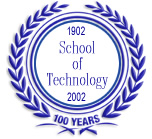
"Technology
and Us"
School of Technology
Centennial Symposium
An Extended Celebration

 |
"Technology
and Us" |
 |
|
|
"Just
Radio with Pictures" Marketers today like to "pitch" DTV (digital television) as TV with really great picture and sound. It very much reminds me of when black and white television first became a viable consumer product. It was hawked as "radio with pictures!." Marketers understood that it was easier to sell an enhancement of an existing product that consumers were comfortable with than to try to sell an entirely new concept. And in its infancy, it wasn't really anything much more than radio with pictures. Many of the first national programs were adapted from radio counterparts like Gunsmoke, Amos and Andy, and many of the soap operas. But I doubt that many people today would describe television as just radio with pictures. The way we use the two media is almost entirely different. The times of day, the physical locations, and the entertainment experience we seek are quite diverse from each other for most Americans. Likewise, I am convinced that the future of DTV is much, much more than just TV with really nice pictures and sounds. It will not be many years before we view nascent DTV as quaint and dated as the TV version of Amos and Andy. Not because production standards will have progressed or social morays changed but because the technology itself will seem so limited. We will look back at the Internet with the same sense of nostalgia. Those of us that were in the select club of pre-web users of the text-based, wired world, can now hardly remember the arcane contortions we went through just more than a decade ago to communicate with others around the nation and globe on an information highway that more resembles a goat path. Those memories lost now in what at times we now think of as the blinding lights and raucous sounds of a broadband Autobahn. The ultimate DTV will be the love child of a dysfunctional love affair between the Internet and television. But it will be a (please excuse the use of such a tired phrase) convergence of what we now view as competing media technologies. Our grandchildren will understand the concept of a modem with as much clarity and interest as our children comprehend the butter churn. Words like "keyboard" and "mouse" will be about as relevant as the word "dial" is to a telephone. They will be incredulous at the concept that people actually scheduled their lives to meet a box at a particular time and all they got out of it was a set of one-way sounds and pictures sent to their home. I doubt it will be called DTV or digital television or Internet or "online" anything. It will be multi-dimensional medium so integrated into the home, workplace and school that our grandchildren will look at it as something no less mundane than today's telephone. Their education and entertainment will be dominated by multi-media interactive content integrating voice recognition, multi-point conferencing with which they interface in holographic virtual reality. And
when those of us around at the beginning of this whole DTV thing try to
explain the history of it to them it will make no sense at all when we
try to use words like "just radio with pictures." |